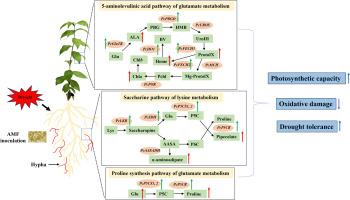Arbuscular mycorrhizal symbiosis enhances the drought tolerance of Populus cathayana by modulating glutamate and lysine metabolism
IF 6.8
Q1 PLANT SCIENCES
引用次数: 0
Abstract
Arbuscular mycorrhizal fungi (AMF) can effectively increase plant drought tolerance by promoting nitrogen (N) uptake. However, the regulatory pathways through which AMF-induced additional N uptake affects plant drought tolerance remain poorly understood. In this study, we investigated the regulation of amino acid metabolic pathways in Populus cathayana under drought stress (DS) by the arbuscular mycorrhizal (AM) fungus Rhizophagus irregularis. We found that AM symbiosis improved chlorophyll fluorescence parameters and root system characteristics, decreased electrolyte leakage, leaf H2O2 content and root malondialdehyde content in P. cathayana under DS, increased the contents of key intermediates in the 5-aminolevulinic acid (ALA) pathway (leaf ALA, Proto IX, chlorophyll a and heme), proline synthesis pathway (root glutamate, proline, pipecolic acid, and α-aminoadipate), and associated regulatory genes (leaf PcGluTR, PcPBGD, PcFECH1, PcFECH2 and PcHO1; root PcLKR, PcSDH, PcP5CS1 and PcP5CS2) expression. These results indicated that AM symbiosis improved photosynthesis and alleviated the oxidative damage caused by DS, thereby increasing drought tolerance in plants. These effects are attributed to AMF inoculation promoting chlorophyll and heme synthesis by regulating the ALA pathway in glutamate metabolism in leaves and promoting the synthesis of proline, pipecolic acid, and α-aminoadipate by regulating the proline synthesis pathway in glutamate metabolism and the saccharopine pathway in lysine metabolism in the roots. These findings reveal the potential regulatory mechanisms by which AMF inoculation aids the leaves and roots of plants in coping with DS through enhanced N uptake, providing a theoretical basis for applying AMF to improve plant growth under DS conditions.

丛枝菌根共生通过调节谷氨酸和赖氨酸代谢,增强了中国白杨的抗旱性
丛枝菌根真菌(AMF)通过促进植物对氮的吸收,有效地提高了植物的抗旱性。然而,amf诱导的额外氮吸收影响植物抗旱性的调控途径仍然知之甚少。本研究研究了干旱胁迫下丛枝菌根真菌Rhizophagus irregularis对中国白杨(Populus cathayana)氨基酸代谢途径的调控。我们发现,AM共生改善了DS下甘油三酯叶绿素荧光参数和根系特性,降低了甘油三酯电解质渗漏、叶片H2O2含量和根系丙二醛含量,增加了5-氨基乙酰丙酸(ALA)途径(叶片ALA、Proto IX、叶绿素a和血红素)、脯氨酸合成途径(根系谷氨酸、脯氨酸、果酸和α-氨基己二酸)关键中间体含量,以及相关调控基因(叶片PcGluTR、PcPBGD、PcFECH1、PcFECH2和PcHO1;根PcLKR、PcSDH、PcP5CS1和PcP5CS2)的表达。上述结果表明,AM共生促进了植物光合作用,减轻了DS引起的氧化损伤,从而提高了植物的抗旱性。这主要是由于接种AMF通过调节叶片谷氨酸代谢中的ALA途径促进叶绿素和血红素的合成,通过调节根系谷氨酸代谢中的脯氨酸合成途径和赖氨酸代谢中的糖精苷途径促进脯氨酸、果酸和α-氨基己二酸的合成。这些发现揭示了AMF接种通过增强植物对氮的吸收来帮助植物叶片和根系应对DS的潜在调控机制,为AMF在DS条件下促进植物生长提供了理论依据。
本文章由计算机程序翻译,如有差异,请以英文原文为准。
求助全文
约1分钟内获得全文
求助全文
来源期刊

Plant Stress
PLANT SCIENCES-
CiteScore
5.20
自引率
8.00%
发文量
76
审稿时长
63 days
期刊介绍:
The journal Plant Stress deals with plant (or other photoautotrophs, such as algae, cyanobacteria and lichens) responses to abiotic and biotic stress factors that can result in limited growth and productivity. Such responses can be analyzed and described at a physiological, biochemical and molecular level. Experimental approaches/technologies aiming to improve growth and productivity with a potential for downstream validation under stress conditions will also be considered. Both fundamental and applied research manuscripts are welcome, provided that clear mechanistic hypotheses are made and descriptive approaches are avoided. In addition, high-quality review articles will also be considered, provided they follow a critical approach and stimulate thought for future research avenues.
Plant Stress welcomes high-quality manuscripts related (but not limited) to interactions between plants and:
Lack of water (drought) and excess (flooding),
Salinity stress,
Elevated temperature and/or low temperature (chilling and freezing),
Hypoxia and/or anoxia,
Mineral nutrient excess and/or deficiency,
Heavy metals and/or metalloids,
Plant priming (chemical, biological, physiological, nanomaterial, biostimulant) approaches for improved stress protection,
Viral, phytoplasma, bacterial and fungal plant-pathogen interactions.
The journal welcomes basic and applied research articles, as well as review articles and short communications. All submitted manuscripts will be subject to a thorough peer-reviewing process.
 求助内容:
求助内容: 应助结果提醒方式:
应助结果提醒方式:


